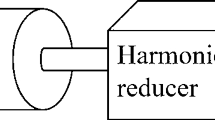Abstract
In order to improve the trajectory tracking precision and reduce the synchronization error of a 6-DOF lightweight robot, computed-torque deviation coupling control strategy based on friction compensation analysis is presented. The mathematical models of the robot which include kinematic model and dynamic model are established. The single joint Lugre friction model is proposed, and the parameters of the friction model are identified by experiment. Since it is difficult to describe the real-time contour error of the robot for complex trajectory, the adjacent coupling error is analyzed to solve the problem. Combined with friction compensation and coupling performance of the robot, computed-torque deviation coupling controller is designed and validated by simulation analysis. A servo control experimental system is constructed, and verified that the synchronization error are significantly decreased and the trajectory error is reduced from (−0.8°~1°) to (−0.230°~0.587°) after the friction compensation is added. The effectiveness of the control algorithm is validated by the experimental results, thus the control strategy can improve the robot’s trajectory tracking precision significantly.
Access this chapter
Tax calculation will be finalised at checkout
Purchases are for personal use only
Similar content being viewed by others
References
Li, Z.B., Wang, Z.L., Li, J.F.: A hybrid control scheme of adaptive and variable structure for flexible spacecraft. J. Aerosp. Sci. Technol. 8(5), 423–430 (2004)
Hwang, C.L., Chao, S.F.: A fuzzy-model-based variable structure control for robot arms: theory and experiments. In: IEEE International Conference on Systems, Man and Cybernetics, vol. 6, No. 6, pp. 5252–5258. IEEE Xplore (2004)
Chen, Y., Ma, G., Lin, S., et al.: Computed-torque plus robust adaptive compensation control for robot manipulator with structured and unstructured uncertainties. J. Ima. J. Math. Control. Inf. 33(1), 37–52 (2014)
Jankovics, V., Mátéfi-Tempfli, S., Manoonpong, P.: Artificial neural network based compliant control for robot arms. In: Tuci, E., Giagkos, A., Wilson, M., Hallam, J. (eds.) SAB 2016. LNCS, vol. 9825, pp. 91–100. Springer, Cham (2016). doi:10.1007/978-3-319-43488-9_9
Tien, L.L., Albu-Schaffer, A., Luca, A.D., et al.: Friction observer and compensation for control of robots with joint torque measurement. In: IEEE/RSJ International Conference on Intelligent Robots and Systems, pp. 3789–3795. IEEE Press (2008)
Alonge, F., D’Ippolito, F., Raimondi, F.M.: Globally convergent adaptive and robust control of robotic manipulators for trajectory tracking. J. Control Eng. Pract. 12(9), 1091–1100 (2004)
Liu, X., Li, H., Wang, J., Cai, G.: Dynamics analysis of flexible space robot with joint friction. J. Aerosp. Sci. Technol. 47, 164–176 (2015)
Zhu, Y., Pagilla, P.R.: Static and dynamic friction compensation in trajectory tracking control of robots. In: IEEE International Conference on Robotics and Automation (ICRA), vol. 3, pp. 2644–2649. IEEE Press (2002)
Gu, K., Cao, Q.: Control system design of 6-DOFs serial manipulator based on real-time ethernet. In: IEEE International Conference on Information and Automation, pp. 118–120. IEEE Press (2014)
Guo, K., Li, S., Huang, D.: Real-time quadruped robot control system based on Xenomai. In: Chinese Automation Congress, pp. 342–347. IEEE Press (2015)
Choi, T., Do, H., Park, D., Park, C.: Real-time synchronisation method in multi-robot system. J. Electron. Lett. 50(24), 1824–1826 (2014)
Li, T., Sun, K., Liu, H., et al.: Optimal measurement configurations for kinematic calibration of six-dof serial robot. J. Cent. South. Univ. Technol. 18(3), 618–626 (2011)
You, W., Kong, M.X., Sun, L.N., et al.: Optimal design of dynamic and control performance for planar manipulator. J. Cent. South. Univ. 19(1), 108–116 (2012)
Zhang, D.L., Zhang, X., et al.: Contouring error modeling and simulation of a four-axis motion control system. J. Cent. South. Univ. 22(1), 141–149 (2015)
Sun, D., Tong, M.C.: A synchronization approach for the minimization of contouring errors of cnc machine tools. J. IEEE. T. Autom. Sci. Eng. 6(4), 720–729 (2009)
Acknowledgments
The authors would like to thank the financial support from the National Natural Science Foundation of China (61305050) and the National High Technology Research and Development Program of China (2015AA043102) and (2015AA043003).
Author information
Authors and Affiliations
Corresponding author
Editor information
Editors and Affiliations
Rights and permissions
Copyright information
© 2017 Springer International Publishing AG
About this paper
Cite this paper
Yan, Y., Liang, L., Chen, Y., Wang, Y., Liu, Y. (2017). A Method of Computed-Torque Deviation Coupling Control Based on Friction Compensation Analysis. In: Huang, Y., Wu, H., Liu, H., Yin, Z. (eds) Intelligent Robotics and Applications. ICIRA 2017. Lecture Notes in Computer Science(), vol 10463. Springer, Cham. https://doi.org/10.1007/978-3-319-65292-4_69
Download citation
DOI: https://doi.org/10.1007/978-3-319-65292-4_69
Published:
Publisher Name: Springer, Cham
Print ISBN: 978-3-319-65291-7
Online ISBN: 978-3-319-65292-4
eBook Packages: Computer ScienceComputer Science (R0)



